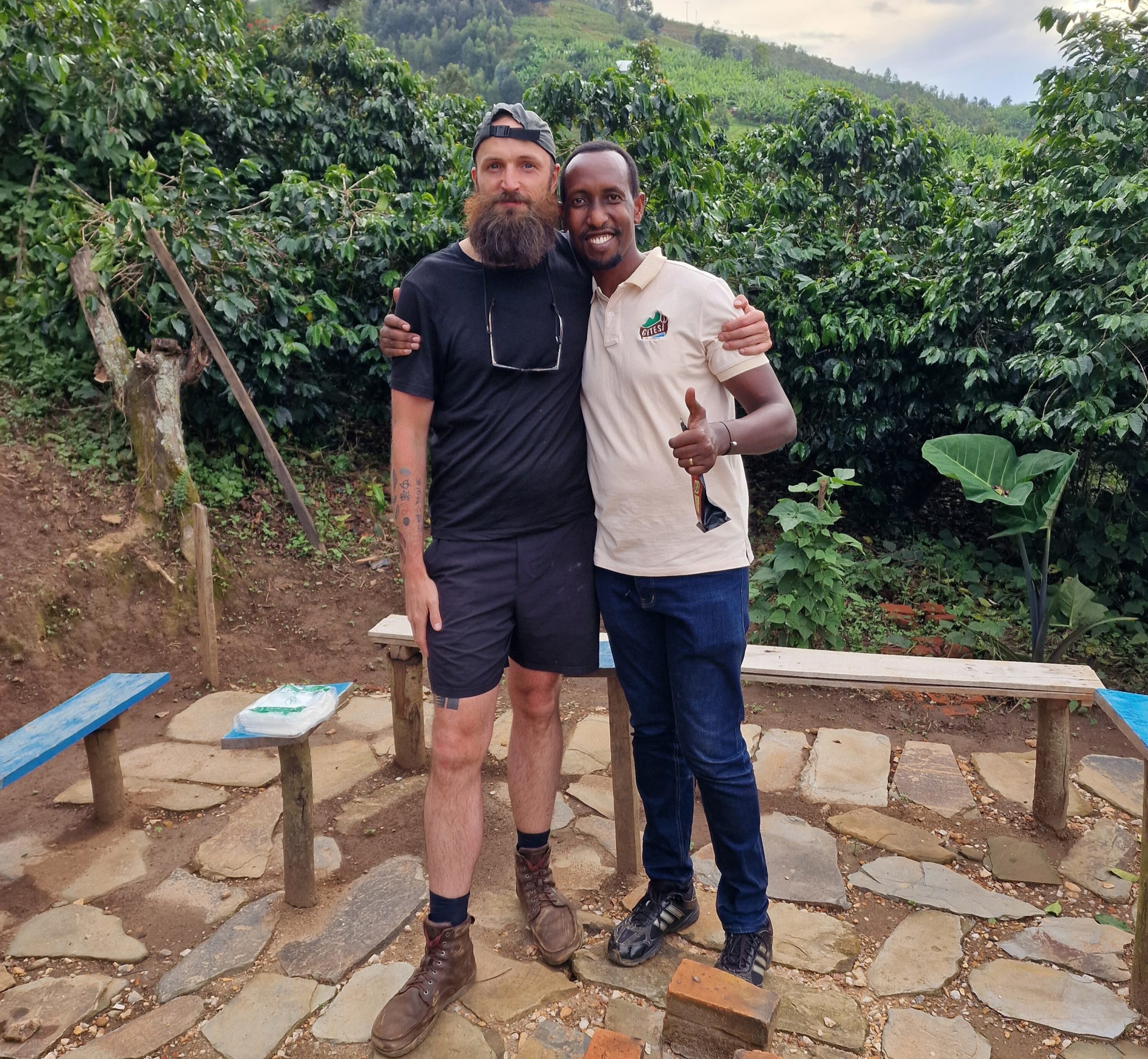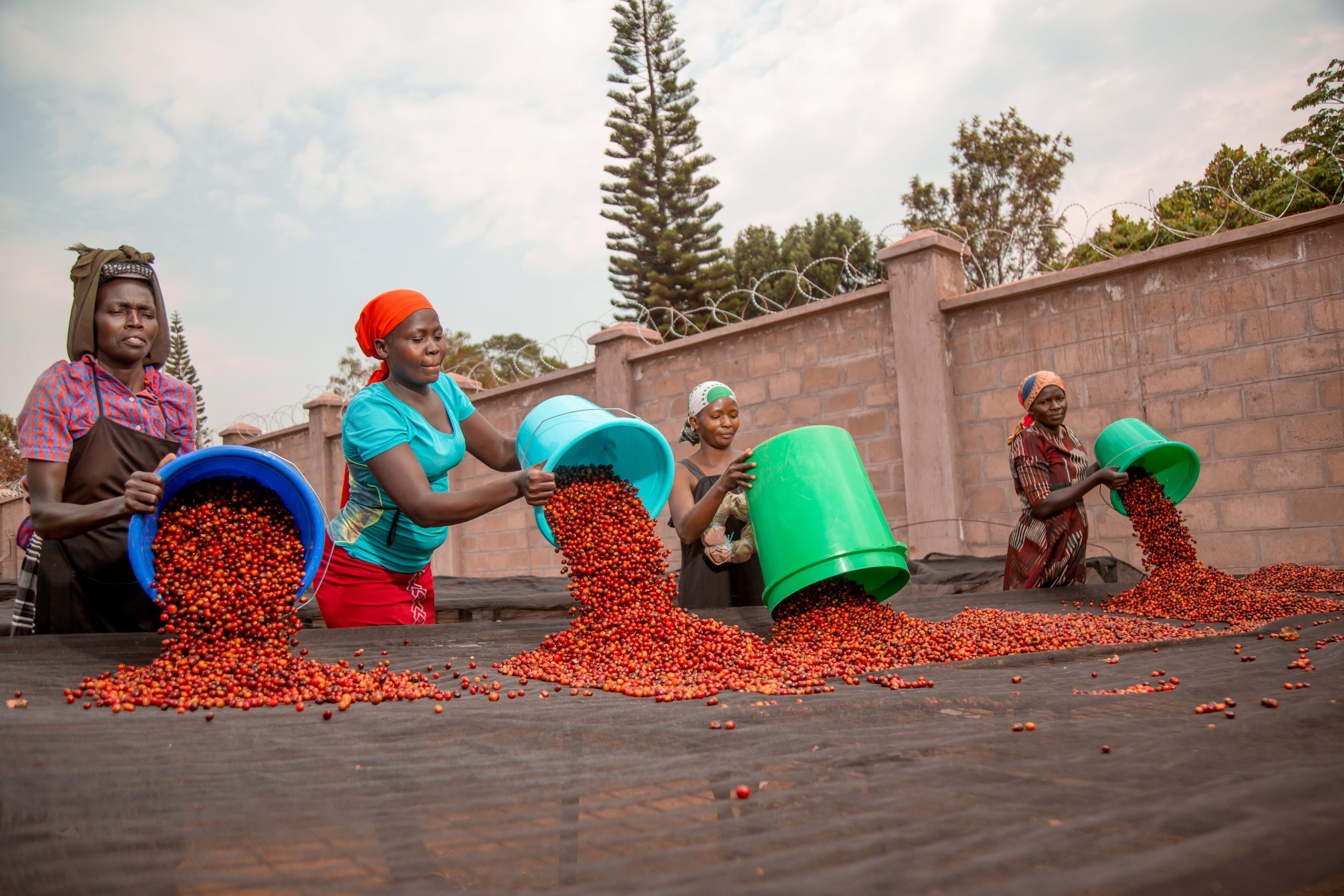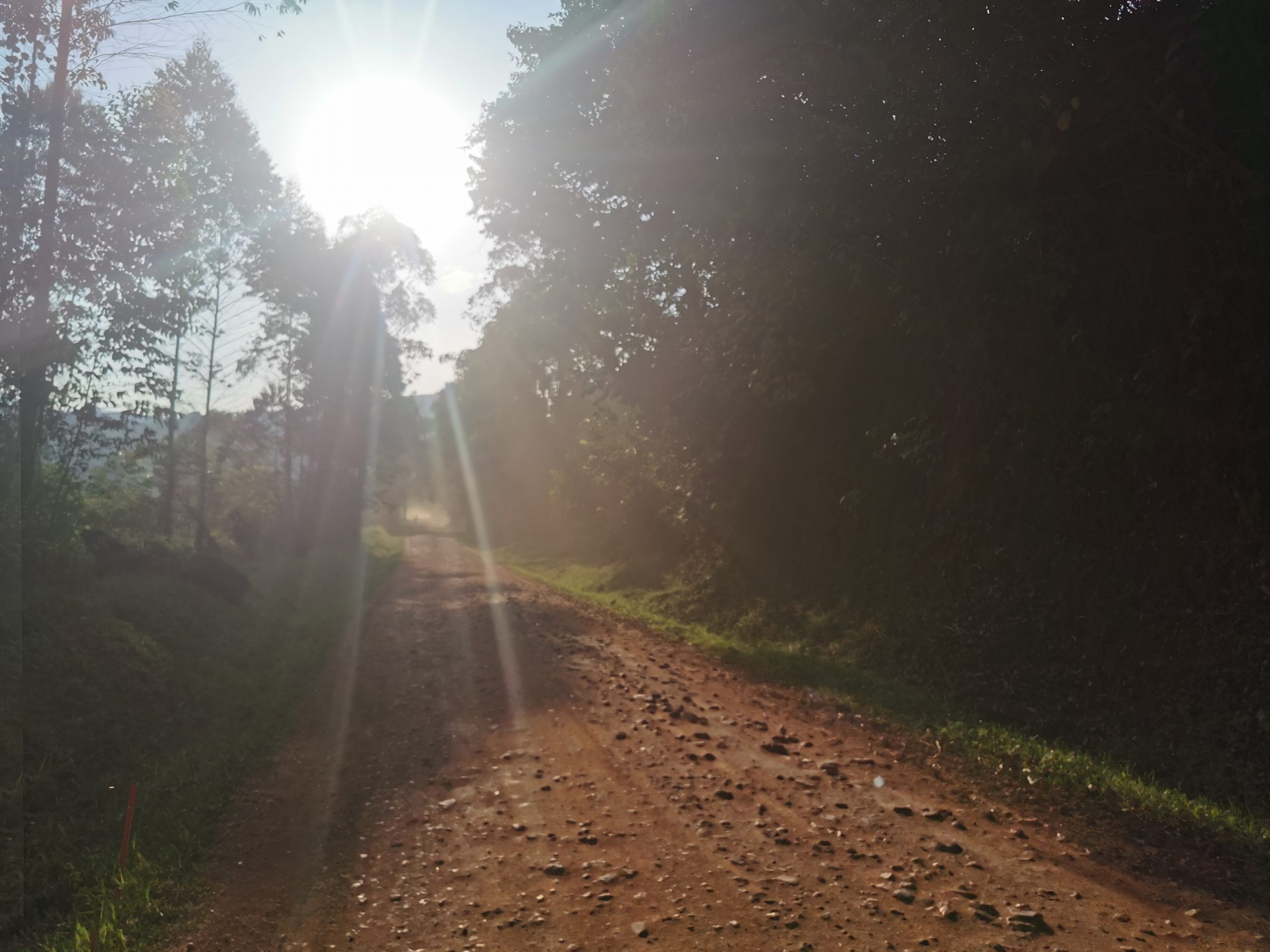Our sourcing strategy
We see Uganda as a high scoring specialty origin “in the making”. There are so many good coffees around, on the trees at least. However very little investment has been made in post-harvesting, or in the supply chain in general, so the country has struggled to achieve its full potential. This suits us well; we love a challenge.
The great potential in Uganda is in naturals and special preparations. We are working to develop protocols to deliver new flavour concepts on scale, both for naturals and washed. So far we have mapped out three areas and concepts that we think have great potential. Most of our volume comes from high-quality naturals, but we are also working on washed coffees.
After quality, our main criteria when buying is that the coffees are fully traceable, including the premiums we pay, which must go directly to the producers.
The cup profiles
Our coffees can be divided into the following categories.
- Classic naturals:
Clean and distinctive with typical mature berry flavors, pronounced fermentation towards strawberry and raspberry, as well as fruity cacao. - Wild and boozy naturals:
More lactic and/or alcoholic, often anaerobic or semi-anaerobic fermentation. Fruity, mature stonefruit, sometimes yoghurt-like, with everything from candy-like tutti frutti to banana and sweet spices like cinnamon, cardamom, ginger and herbs. - Classic washed:
Clean with good depth, mild florals, currant and grape-like, mild herbal, bright and clean. - Fruity washed:
Fully washed with different levels and methods of fermentation, sometimes anaerobic or semi-anaerobic, more layers of fruit and mild fermentation flavours, often reminiscent of good honey processed coffees.
The value chain
Most coffee in Uganda is home processed, meaning the farmers pick the cherries and either depulp it with a hand pulper, or simply dry the cherries on a tarp. We don’t buy home processed coffees as we find them inconsistent in quality and traceability. Instead, our buying programmes are based on a centralised processing/drying facility.
Our smallholder coffees
Ugandan farmers commonly own less than a hectare of farmland. For the washed coffees, our farmers deliver cherry to a small washing station who process and dry the coffee on-site, or move it to a central drying space. For naturals, the farmers deliver cherry either to a bigger centralised drying station that specialises in naturals, or to local cherry collection centres, before the coffee is transported to the drying facility. Washing stations deliver the parchment to exporters who cup and grade the coffee, dry mill, and export the finished green coffee.
Our estate coffee
In this case the producer has their own washing station/mill and drying space at the estate. They process all their own coffees here, plus they buy cherries from outgrowers (neighboring smallholders). Coffees are picked and immediately transported to the wet mill for pulping, fermentation, drying. The coffees are then moved to an exporter’s warehouse where they wait to be milled and shipped according to our instructions. The producer owns the coffee outright, and pays the exporter for services like dry milling, grading, bagging, quality control, documentation, and logistics.
The relationships
As for most origins we work in, we are focused on smallholders and seek local partners with these relationships. In Uganda we have also partnered with a small estate who processes their own coffee as well as coffees from the surrounding outgrowers (smallholders).
Kingha Estate
We are working with Kingsley Griffin, founder and manager of Kingha Estate, to develop new concepts for washed coffees. Together we develop processing protocols, and Nordic Approach pre-contracts these coffees, and pre-finances part of the process. Kingha Estate also buys cherries from surrounding smallholders, most of whom have never previously had access to the premium market.
Great Lakes Coffee (GLC)
This exporter has recently invested in something they call the “Coffee Yard”, a coffee drying facility where they have built really nice tables for quality production of naturals. We are also conducting trials on washed coffees from surrounding washing stations and dry these coffees at the Coffee Yard, all special preparations. GLC currently have two drying yards, Kasese in the West, and Sironko in Mbale in the East.
The challenge
Unlike other East African origins where it is easy to visit, cup, and select from existing stock lots of specialty coffees, Uganda doesn’t have a selection of good quality coffee just sitting around. You have to plan before the harvest season. We plan with our suppliers, commit to volumes, pre-contract and where possible, pre-finance to ensure the output we’re seeking.
Home processed coffees dominate the coffee sector, accounting for 85-90% of Ugandan production. Farmers dry their own cherries, often on plastic or tarp. If the coffee is washed, they use a small and simple hand pulper. The inconsistent and low quality of these coffees means they are mostly sold for unsustainably low prices.
We know the quality of Ugandan coffee can be amazing if it’s processed well. These coffees deserve a place in the specialty industry and Ugandan producers should have access to specialty premiums.
There are very few washing stations in Uganda in general. The big multinationals are investing in washing stations but most farmers prefer to home-process their coffee. Exporters and locals also hesitate to invest in washing stations as there is a lot of theft and mistrust in the industry. Very often they have to move parchment into the storage at night to avoid it being stolen. In many cases the producers pulp, ferment and pre-dry the coffee at the washing station, then move the wet parchment down to towns like Mbale to finish the drying mechanically or on black plastic in guarded commercial drying plots.
The “potato’ defect
Does it exist in Ugandan coffees? Yes, but it is much less prevalent than in countries like Rwanda and Burundi. The Potato Taste Defect (PTD) is caused by a small bug called Antestia that feeds on the cherry and leaves some bacteria, creating a metabolic reaction. Farmers can reduce the risk by using pesticides and thoroughly sorting cherries.
There is never a guarantee against PTD, not even in the best coffees, but the Ugandan coffees are so tasty and such good value for money, it is worth the risk. In collaboration with our producers, we have implemented improved picking and intense sorting procedures at every stage of processing which has reduced PTD to a minor worry.
Background info
Total production 4,2 million bags, 250,000 metric tonnes.
There are about 1,7 million households producing coffees. The average farm size is 0,18 hectares. Arabica is grown from 1000 – 2300 masl.
For comparison, Rwanda produces about 20,000 metric tonnes, and has about 400,000 households producing coffee.
Around 40% of Uganda’s coffee production is Arabica, and that amounts to a lot of coffee. About 70% of this is processed as a natural. There is generally a biannual production cycle where they have a larger crop every second year.
Uganda is geographically divided into the main regions, North West, West, South West, East for Arabica production, and Central region only for Robusta.
The West and South West are the biggest regions for Arabica production. North West is smaller, but figures may not be accurate as many Congolese coffees are “smuggled” over the border and sold as Ugandan.
Politically and geographically Uganda is divided into districts, counties, sub-counties and parishes. Within the parish there are villages. Each district has a Governor elected by the people and each county has a member of parliament.
In the east you have the Bagisu tribe in the lowlands and Sabino in the highlands, as in Kenya. West has a big tribe called Bakonzo who live on the Rwenzori mountain range both in DR Congo and Uganda. North West is mainly the Acholi tribe. In the south west there is the Batchiga tribe.
The varieties
There are a good number of SLs, similar to Kenya, most commonly SL14, SL34, and SL28. Bourbon seems to be common too, especially in the west. Depending on the altitudes and area, there are also a lot of Catimors. Most of the farmers have coffee gardens and are not generally aware of what varieties they are growing. Often it is a mix.
Planting and production
The coffees come from smallholder communities, mostly farmers working with less than 1 hectare each. On average, farmers cultivate less than 1500 trees per hectare, and one tree typically produces a quantity of cherries equal to 100 – 200 grams of green coffee.
The farms are managed by the family members, and located in parishes, or communities. The family cares for the plants and picks the cherries themselves. Usually they will also grow crops for their own consumption, and there are a few farmers with more land.
Each parish is the administrative centre for between seven and twelve villages. These villages can be home to as few as 200 people. Farmers often work communally with a leader for each group of farms. Our Ugandan coffees are mostly from different parishes, with the occasional lot from a communal washing station.
There is almost constant harvest in Uganda if you look across the different regions, and it will vary based on the rains and weather. Generally Mbale in the east has the main season from November – February, and a fly crop around May – June. West and South West have one season from March – May, and another from August – November. This can always shift a little depending on the region, weather and the altitude of the farm.
Processing
Cherry reception
For the natural processed coffees, cherries are either delivered directly to the drying stations, or purchased in the local villages and transported to the central processing facility. A dedicated and specialised team manages the protocols and standards for cherry purchase, sorting and floating before buying, as well as fermentation and drying process with the strictest QC controls at every stage of the process.
In the case of washed coffees, the managers and owners of the washing stations oversee the cherry purchase. The washing station buys cherries from local smallholders. With the support of agronomists they implement good routines for cherry reception and sorting, cherry delivered by farmers must be sorted by the farmers themselves, if this is not done sufficiently there are staff who will do further sorting.
Fermentation, washing and drying
There are different types of processing, depending on the region.
Naturals in the East:
Most of our coffees undergo a semi-anaerobic fermentation. After cherry reception the coffees are laid out on African beds for pre-drying, and cherries are sorted as they dry. The coffee is then placed in drums or polypropylene bags for additional fermentation in cherry. This can last for 12 – 48 hours, after which it is laid on the table. Layers are adjusted accordingly to meet the projected time for final drying, normally 10 – 18 days.
Naturals in the West:
These are usually dried without additional fermentation. Coffee cherries are laid out on the bed in specific layers, depending on the level of fermentation the producer wants to achieve. We have a separate protocol for cherry fermentation under plastic, before coffees are dried according to standard procedures for naturals.
Washed in the East:
Coffees at the washing stations are pulped with eco pulpers before they are dry-fermented in small plastic or concrete tanks. The coffee is then washed and rinsed before it is dried on raised beds.
Washed South West/Kingha
Coffees from the farm are picked and go straight into processing. We have different levels and methods of fermentation both in cherry and in parchment. Cherry fermentation is done on plastic in the open air, or in bags before the coffees are pulped with an eco-pulper and treated like regular washed coffees before they are dried on raised beds.
Regular washed or additional fermentations are also done in different ways. Generally fresh cherries are harvested and pulped immediately by an eco pulper. They are then either fermented in bags or in regular fermentation tanks for different periods of time, depending on the level of fermentation and flavours we want to produce. All coffees are carefully dried on raised beds, mostly under shade and cover.
At a glance:
Harvesting season: Almost all year
Arrival times: July – August, January – April
Quantities: 10- 20 bag micro lots, 100 + bag communal lots
Packaging: 60 kg Grain pro
Price levels: 9 – 11 USD/lb
Cultivars: Mixed SL varieties, SL 14, 28, 34, Bourbons, catimors
Processes: Naturals and washed, various fermentation methods.
Usage: Filters and espressos, special editions
Shelf life: We can never guarantee more than 6 months after arrival for any coffees
Uganda Videos
Uganda Blog Posts

UGANDA & RWANDA ORIGIN TRIP
UGANDA THE EAST On the 3rd of May, I set out on a 2 week trip to Uganda and Rwanda. After a long night flight, I set my first steps back into the welcoming heat of Uganda’s tropical weather. Quite the contrast with Oslo, where it was still grey and […]

OUR PROJECT IN BULAMBULI: STRENGTHENING UGANDA’S POTENTIAL
Uganda is a high-scoring specialty origin that is still under construction. Most of its coffee is strip picked and cultivated for mass production, as little investment has been made to develop its quality further. If you scratch beneath the surface, there is a lot of potential in quality naturals and […]

Uganda harvest update
Good day! I was lucky enough to travel to Uganda in April, taking every precaution and being tested ten times a day, or at least that’s what it felt like. What a beautiful journey through Uganda it was. There’s a good reason we took the calculated risk to travel. Firstly, […]